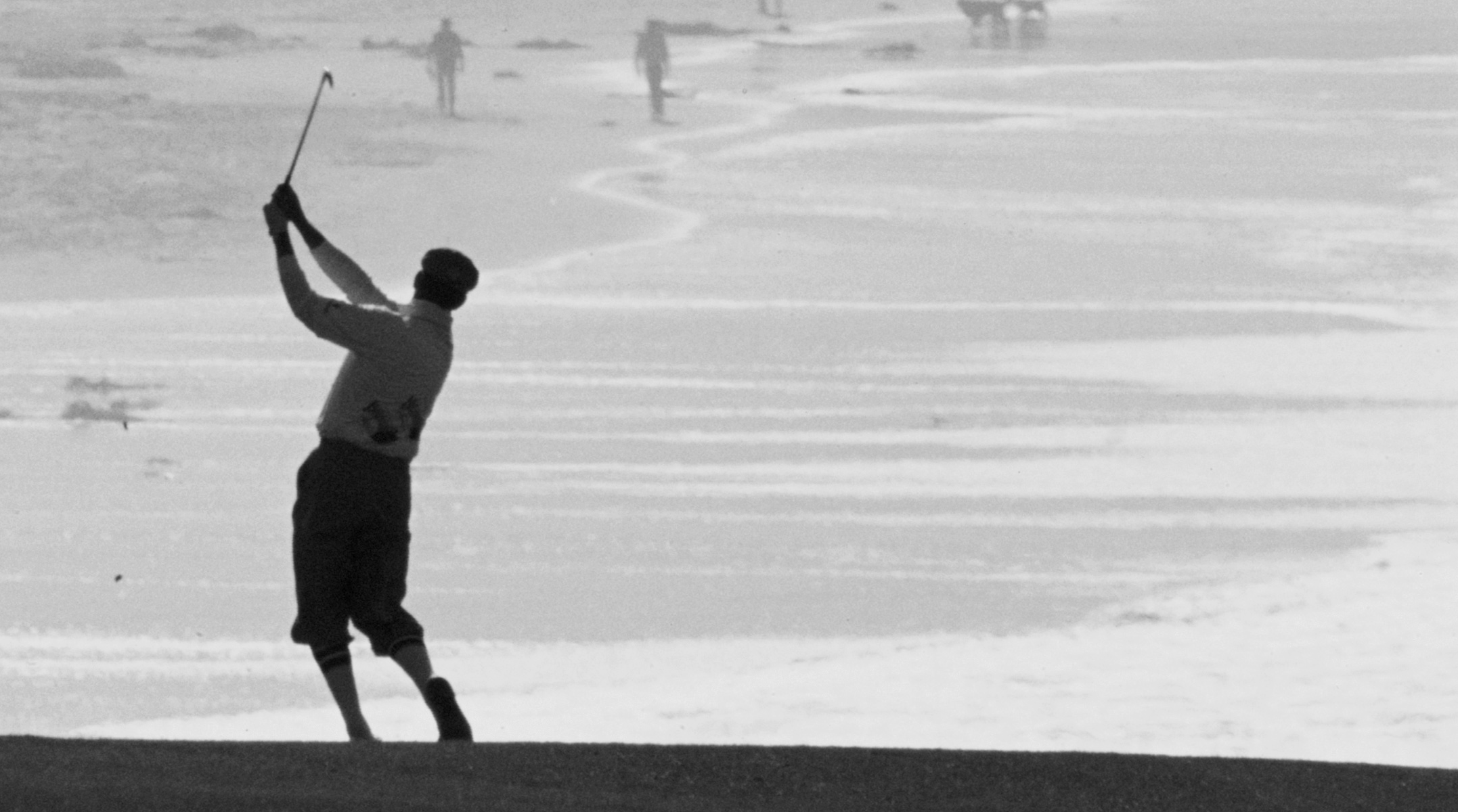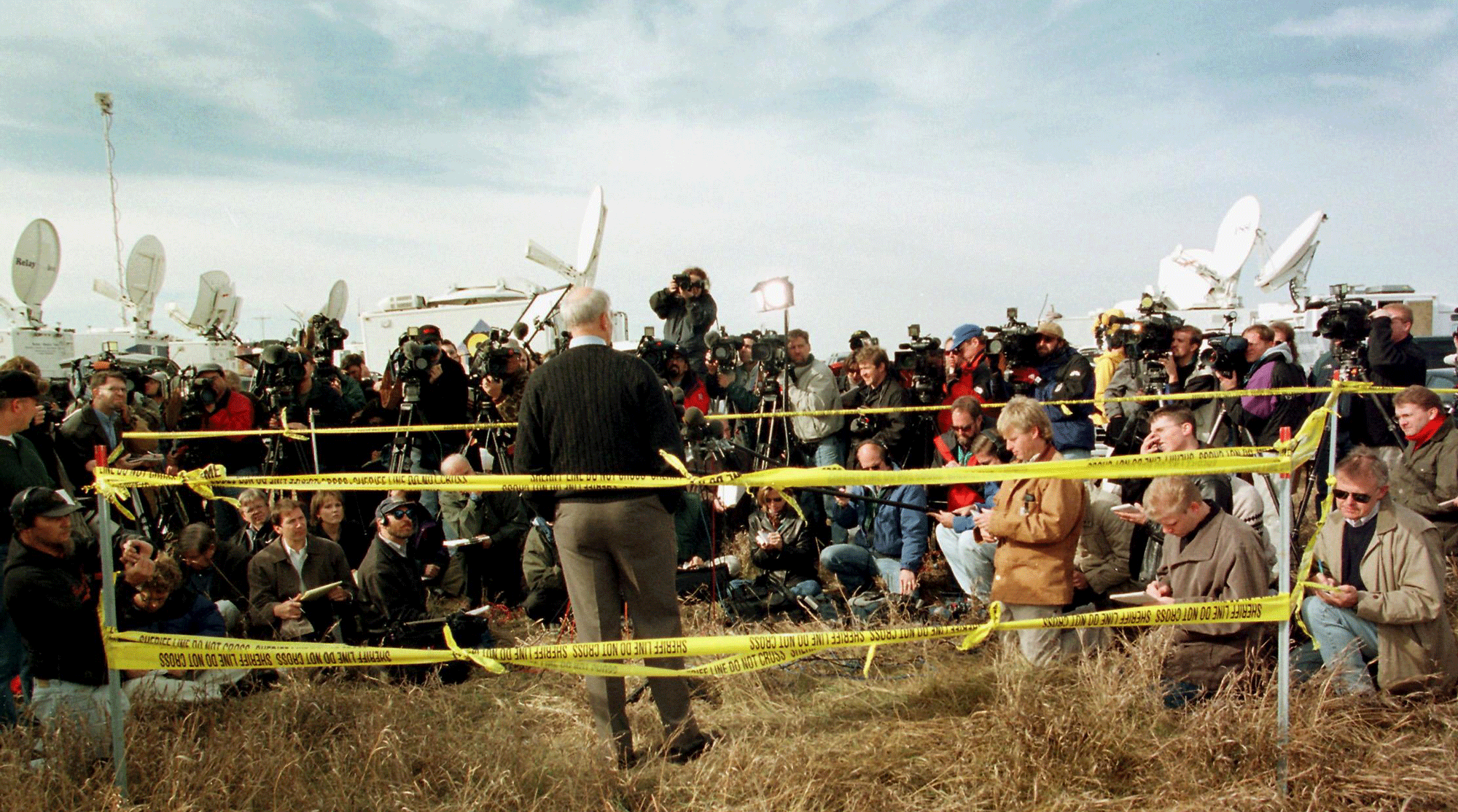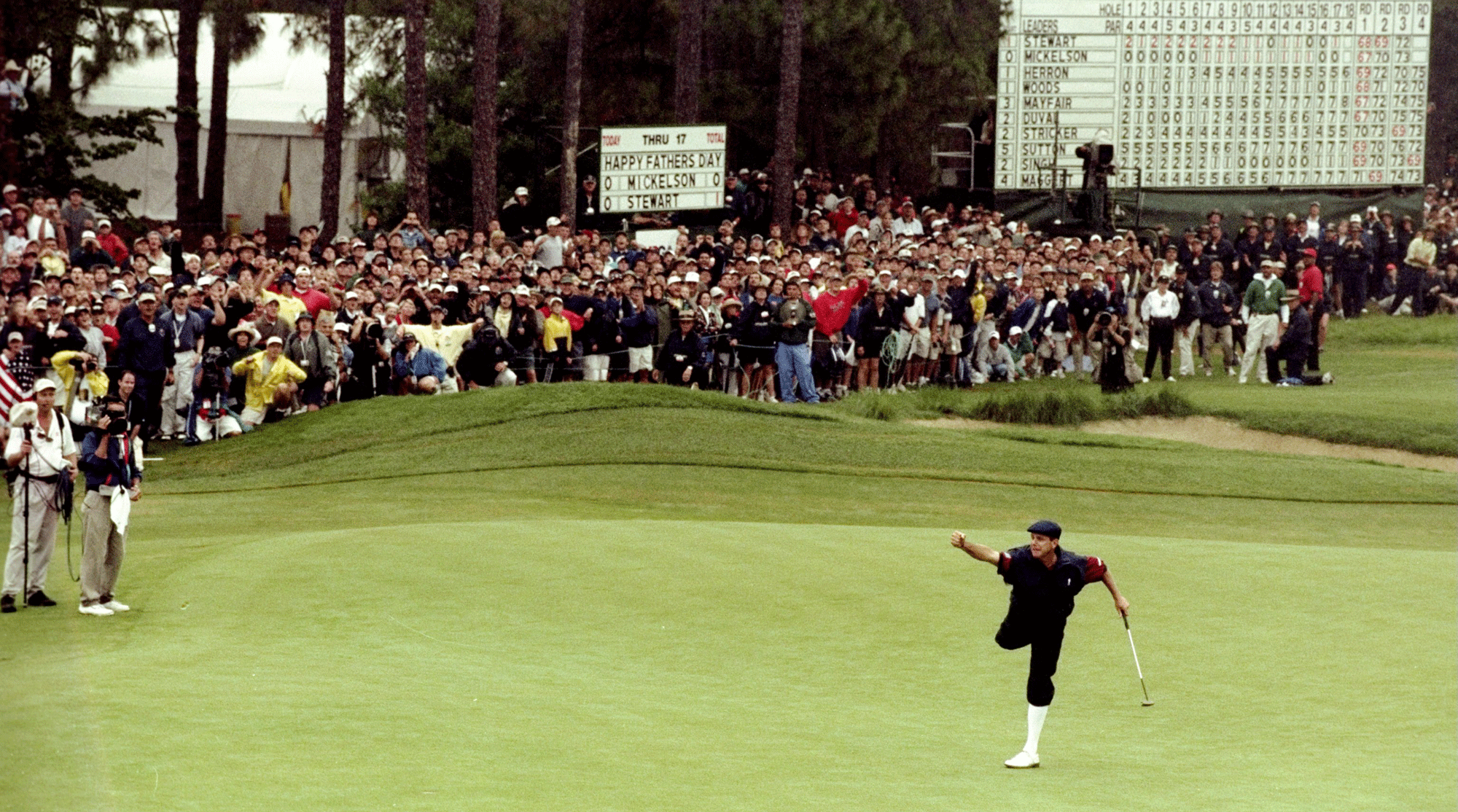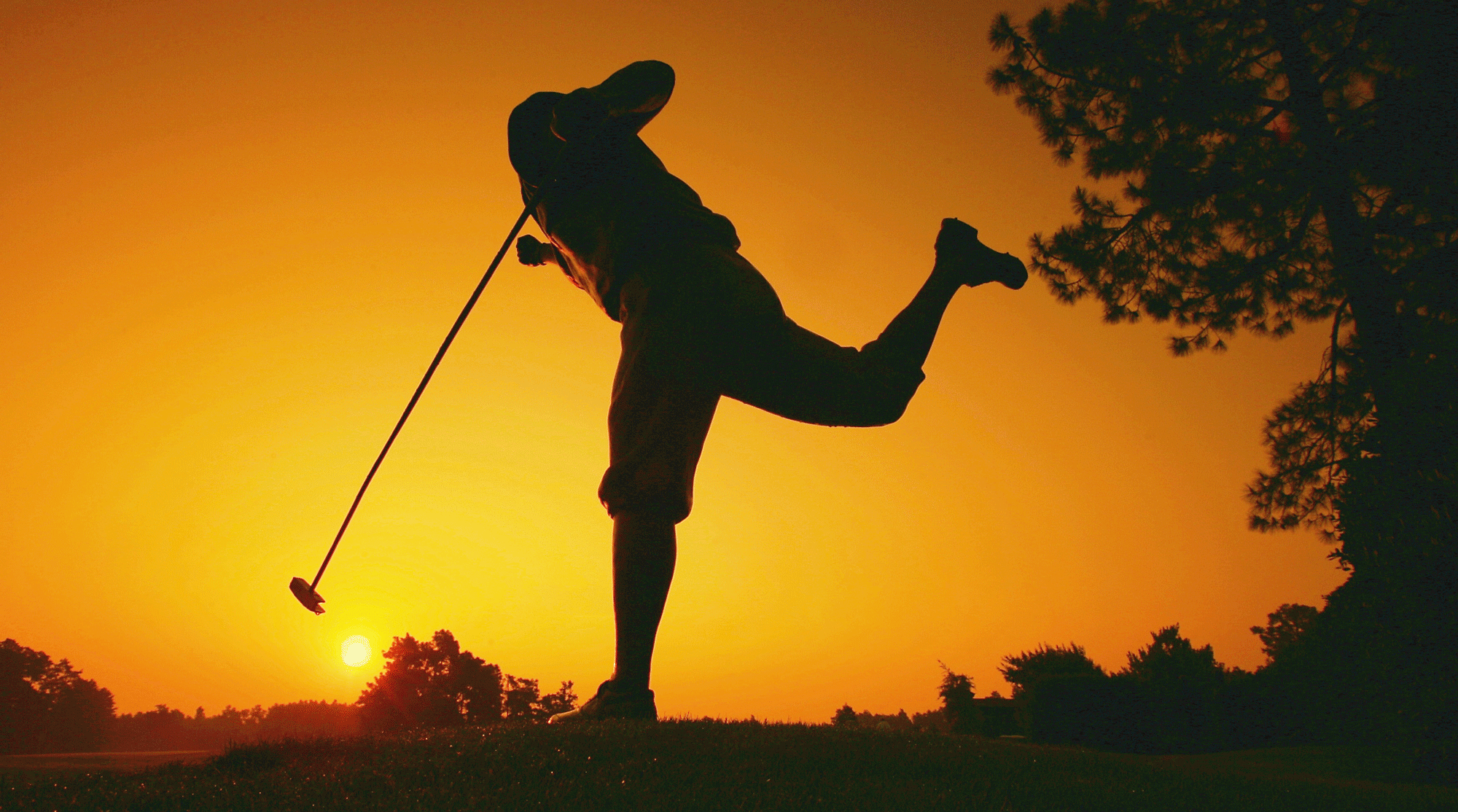
Twenty years after Payne Stewart’s death, questions linger about his legacy, both as a player and a man
News traveled swiftly that Monday, none of it good, not all of it accurate. CNN was the first to report of a Learjet flying aimlessly toward the Great Plains after departing Orlando at 9:19 that morning. Both pilots had been unresponsive to radio contact for hours, and when F-16s were dispatched on three separate occasions to assess the situation — there were also four passengers on board — they detected an ice-covered cockpit windshield and a lack of flight control.
The identity of those on the flight, however, remained unconfirmed well into the afternoon. Officials revealed only that a professional golfer was on board. Perhaps the information was being withheld until next of kin could be notified; at least one network reported the aircraft would be shot down by the U.S. military, which the Pentagon firmly denied.
It was a tragic and eerie way for Payne Stewart to die. On Oct. 25, 1999, one of the most colorful and popular players of his generation perished in real time, with the world looking on, before there was any official acknowledgement. (Also on board were Stewart’s agents, Van Arden and Robert Fraley, and Bruce Borland, a course architect with Nicklaus Design.) A thousand miles due north of Dallas, Stewart’s intended destination, his life came to a cataclysmic end.
“You got a number for him?” my editor asked.

The question made me uneasy. You want me to call Payne Stewart and ask him if he’s … still alive? I ducked back into my cubbyhole and pressed the numbers, my hand quivering by the end of the first ring, my conscience applying for a pardon by the end of the third. When my call finally went to voicemail, there was Payne’s chirpy, Ozark twang, rolling through the perfunctories in his trademark mix of faux interest and amusement.
Twenty years later, all I remember about my message is how it ended.
With a goodbye.
***
No American golfer born in the 1950s or ’60s won as many major titles (three) as William Payne Stewart. This rarely cited achievement speaks volumes about the man and the era in which he excelled, a period of European dominance that also featured Greg Norman of Australia and Nick Price of Zimbabwe playing leading roles on the game’s world stage. Before Tiger Woods turned the game on its head, pro golf’s competitive landscape was more democratic and geographically diverse.
Even still, Stewart was hardly considered America’s top player. Fred Couples spent three months atop the World Ranking in 1992 and won a pair of Vardon Trophies, in 1991 and ’92; Stewart peaked at third in the world. Davis Love III won a dozen Tour events in the 90s, twice as many as Stewart.
“He was finally starting to get the credit for being the player he was,” says longtime friend Paul Azinger. “Never got it like he should have until right before he died. And I didn’t know how famous he was until he passed away, either.”

Stewart was famous because he played his best golf in the biggest moments. Most Tour pros would be overjoyed with 11 career victories, but was that total sufficient for a three-time major champion who so nearly added two more? Stewart had three four-year stretches when he didn’t win a tournament — droughts that cumulatively comprised about two-thirds of his time on the PGA Tour.
Mike Hicks was Stewart’s caddie for the final 11 of those 18 seasons. “If Dick Coop hadn’t come on board, Payne never would have become the player he became,” Hicks says of Stewart’s sports psychologist. “You can’t overstate the impact Dick had. Absolutely huge.”
If Stewart’s flowing golf swing was a physical work of art, his internal wiring was, shall we say, complex. He was afflicted with attention-deficit hyperactivity disorder (ADHD), a condition from which Coop was able to extract the assets and make Stewart a better player, especially in pressure situations. Today doctors commonly prescribe medication to treat ADHD, turning people with an inability to focus or concentrate into single-minded, mentally resilient achievers. But 30 years ago, those meds weren’t nearly as advanced or versatile.
Take the 1999 U.S. Open, especially the final round. Stewart, the self-appointed clown prince when the situation warranted one, was hyper-focused: chomping on gum, looking nowhere but straight ahead, burrowing through the task that would become his defining legacy. He was an imperturbable badass on that drizzly afternoon at Pinehurst, which is a highly favorable mindset when Phil Mickelson, Vijay Singh and Woods are aiming to derail your return to glory.
“He very, very rarely got to that point,” Hicks says. “I did zero that week. I think I pulled one club for him the entire tournament, and that was a layup on the 10th hole in one of the earlier rounds. Payne could get there at the majors. Coop wanted me to tell him the same thing every time: ‘Get to your spot, nice and slow. Focus on the intermediate target.’ The repetition was very important.”

So is equipment. Upon winning his first U.S. Open eight years earlier, Stewart had emerged as a mainstream needle-mover at a time when pro golf was in desperate need of one. A handsome American who wears plus-fours and knickers, loves his country and morphs into a superhero on Sunday afternoons? What’s not to like? Sponsors certainly took note. In late 1993, Stewart left Wilson Staff, his longtime ball and club provider, to sign a five-year deal with Spalding worth well north of $1 million per year to use its Top-Flite line of products.
It was the equivalent of Orville Wright taking a payday to fly with cement propellers. “That was an unfortunate move from a competitive standpoint but a very good one in terms of financial stability,” says Lamar Haynes, who played collegiate golf with Stewart at Southern Methodist and became one of his best friends. “He’d never played offset irons in his life, and now he didn’t know where the ball was coming from off the face.”
That’s putting it nicely. “Payne let his ego get in the way,” Hicks says. “He didn’t want to play second fiddle to John Daly [at Wilson], so he took the money, and it was a bad decision. I think he’d tell you today that it cost him five years in the prime of his career. There were stretches back then when he didn’t even want to play. They gave him a set of forged, offset irons with square grooves and a ball with an extremely high spin rate, which was ridiculous. If he didn’t have the 10-year exemption [for winning the ’89 PGA], he might not have kept his Tour card.”
In 1994, Stewart plummeted from sixth to 123rd on the money list. His only victory during the Top-Flite years came at the ’95 Houston Open. After playing in four consecutive Ryder Cups, he failed to qualify for the next two. Even Coop couldn’t solve this problem. “Payne had a great pair of hands,” says Mark O’Meara, Stewart’s longtime friend and competitor. “The ultimate feel player, terrific short game, but there were times when it didn’t come easily for him. He had a tough route. Very tough.”
***
Maybe that’s why the man could be such a scoundrel, so self-consumed and rough around the edges. Stewart loved kids and was known for doing some outrageously wonderful things — after winning at Bay Hill in 1987, he donated his entire winner’s check to a Florida hospital in memory of his late father — but there were also instances when his conduct came off as sophomoric or insensitive. Remorse was an option, not an instinct.
Not many Tour pros earn a reputation for heckling players at NBA games, but Stewart seemed to almost covet the label. A passionate Orlando Magic fan and season-ticket holder, he would ride forward Nick Anderson mercilessly. When the situation reached the point of embarrassment, the front office moved Stewart’s seats well off the floor.
Perhaps the most vivid example of Stewart’s tin ear regarding the laws of decorum occurred after he won his first major title at the 1989 PGA Championship. Mike Reid, one of the gentlest men ever to play professional golf, collapsed on the homestretch at Kemper Lakes, turning a wire-to-wire victory into an unbearable loss. Stewart was magnificent on the final nine, birdieing four of the final five holes to beat Reid by a shot, but his post-round behavior was less than gracious.
Reid was in tears as he left the media center. Enter the champion, who announced, “I feel sorry for Mike. God bless him, but I’m not going to kid you about how I feel.” A felony under the laws of sportsmanship? Hardly, but it was the cold tone with which Stewart delivered the line, and his lack of regard as to how it could be perceived, that irked more than a few observers.
Less than a week before his death, Stewart was publicly criticized for mocking an Asian person during an interview with ESPN, which was televising the Tour event in Orlando. Rain had forced a stoppage of first-round play. Stewart agreed to go on-air during the suspension, and at one point, attempted a playful response to recent jingoistic comments by British golf commentator Peter Alliss. (“Americans are totally different than us,” Alliss had said. “They might as well be Chinese. In their eyes, everything in Europe is rubbish. Everything is crap, and that begins to wear on your after a while.”)
Stewart squinted his eyes, protruded his teeth and summoning his attempt at a Far Eastern accent, cracked, “I just want Peter Alliss to know that all of us American golfers on the Ryder Cup team, we are Chinese, too. Thank you very much.”
Not only was his remark nonsensical, but it also revealed a set of cultural blinders on a man with a habit of uttering remarks that wound up on the wrong side of decent. The level of offensiveness spurred by Stewart’s over-the-top antics depended on the offended, but he certainly had an impeccable touch when it came to feather-ruffling.
It was a trait to which those closest to Stewart, especially his wife, Tracey, had become all too accustomed. The guy had a big heart and the courage of a base jumper, but when common sense came knocking, Bill and Bee Stewart’s son didn’t always answer the door.
“His maturation point came at a different time,” Haynes says. “He found his spiritual calling in his early 40s. He was changing. He’d gotten calmer, and he thought before he spoke. It took him a while, but he figured out what life meant.”
***
And then he was gone. Azinger and his wife, Toni, had taken their two daughters to the Disney-MGM Studios Theme Park in Orlando on the morning of Oct. 25. Dad hadn’t qualified for the season-ending Tour Championship in Houston, so this was the start of family time for the Azingers, who climbed into the car for the two-hour drive back to Bradenton.
“Back in ’99, they didn’t have these phones where you could send a text so easily, but I had all these voice messages,” Azinger says. “We got on Interstate 4 and I drove for a while, then I pulled into a rest stop and called my father. He told me what happened and I literally fell to the ground.”
ADVERTISEMENT

They were fishing buddies. Rabble-rousers. Major champions who took the backroads to the big leagues. “I’m just glad I heard the news the way I did, because I didn’t want my daughters to see me when I found out,” Azinger says. “I got back into the car and told everybody. Not another word was spoken the entire way home. We get back to the house, I get out of the car and I fall down again. For some reason, I drove up to the convenience store, and I’m just in a daze. I walk in and the guy behind the counter says, ‘Mister, are you OK?’ I must have looked pretty bad.”
Perhaps 12 hours earlier, O’Meara had arrived at Bay Hill to play in Arnold Palmer’s benefit tournament for his late wife, Winnie. Stewart was also scheduled to participate, then sent Palmer his regrets a few days earlier because he’d be flying to Dallas to look at a golf course project for his alma mater. “Shotgun start, we’re on the 14th or 15th hole, so we get to the clubhouse about an hour later,” O’Meara says. “I run into the locker room, and on the TV, one of the news networks is following this story about a pilot who can’t control his plane.”
A year earlier, it had been O’Meara who redefined himself with a heightened career trajectory. Victories at the Masters and British Open made his body of work a full-blown success at age 41, leaving Stewart, who was born 17 days later in 1957, to follow him up as golf’s fortyish phenom. That said, the two men were strikingly different. Isleworth neighbors with a strong friendship, they weren’t hang-out buddies. Stewart loved attention and dressed like a toucan. O’Meara worked hard and kept things to himself, which is why he got along so well with Tiger Woods.
“I head back out to the first tee, and on the third green, one of the assistant pros drives up and says he needs to talk to me,” O’Meara says. “He brings up the plane I’d seen on TV and tells me they think Payne might be on it. I thanked my partners and left, then drove straight over to see Tracey.”
She has publicly stated that she never should have allowed her husband to board that Learjet 20 years ago, a woman’s intuition stacked against the ramifications of tragedy and all the things we’ll never know. Stewart accomplished much in a relatively short period of time. He touched many lives, made far more money than he could have rightfully dreamed of and left an imperishable footprint on the game he so dearly loved.
Yeah, he might have stepped on a few toes, but as Stewart himself might have told you, that’s the way it goes.

